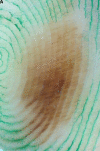Dermoscopy for Acral Melanocytic Lesions: Revision of the 3-step Algorithm and Refined Definition of the Regular and Irregular Fibrillar Pattern
- PMID: 36159128
- PMCID: PMC9464531
- DOI: 10.5826/dpc.1203a123
Dermoscopy for Acral Melanocytic Lesions: Revision of the 3-step Algorithm and Refined Definition of the Regular and Irregular Fibrillar Pattern
Conflict of interest statement
Competing interests: None.
Figures










Similar articles
-
[Dermoscopic pattern analysis of acral melanocytic nevi].Przegl Lek. 2013;70(11):911-5. Przegl Lek. 2013. PMID: 24697028 Polish.
-
Educational and practice gaps in the management of volar melanocytic lesions.J Eur Acad Dermatol Venereol. 2018 Sep;32(9):1450-1455. doi: 10.1111/jdv.14712. Epub 2017 Dec 18. J Eur Acad Dermatol Venereol. 2018. PMID: 29178552 Free PMC article.
-
Age and Anatomical Location-Related Dermoscopic Patterns of 210 Acral Melanocytic Nevi in a Turkish Population.J Cutan Med Surg. 2017 Sep/Oct;21(5):388-394. doi: 10.1177/1203475417712496. Epub 2017 Jun 1. J Cutan Med Surg. 2017. PMID: 28565919
-
Dermoscopic patterns of acral melanocytic lesions in skin of color.Cutis. 2019 May;103(5):274-276. Cutis. 2019. PMID: 31233579 Review.
-
Key points in dermoscopic differentiation between early acral melanoma and acral nevus.J Dermatol. 2011 Jan;38(1):25-34. doi: 10.1111/j.1346-8138.2010.01174.x. J Dermatol. 2011. PMID: 21175752 Review.
Cited by
-
Acral lentiginous melanoma in situ on the palm with a diffuse parallel furrow pattern.JAAD Case Rep. 2024 Oct 16;54:66-68. doi: 10.1016/j.jdcr.2024.09.025. eCollection 2024 Dec. JAAD Case Rep. 2024. PMID: 39654852 Free PMC article. No abstract available.
-
Pattern Analysis of Benign and Malignant Atypical Melanocytic Skin Lesions of Palms and Soles: Variations of Dermoscopic Features According to Anatomic Site and Personal Experience.Life (Basel). 2024 May 22;14(6):659. doi: 10.3390/life14060659. Life (Basel). 2024. PMID: 38929643 Free PMC article.
-
Validation of a Dermatoscopy-Based Algorithm for the Diagnosis of Acral Melanoma.Dermatology. 2024;240(5-6):793-802. doi: 10.1159/000541591. Epub 2024 Oct 5. Dermatology. 2024. PMID: 39369689 Free PMC article.
References
LinkOut - more resources
Full Text Sources
